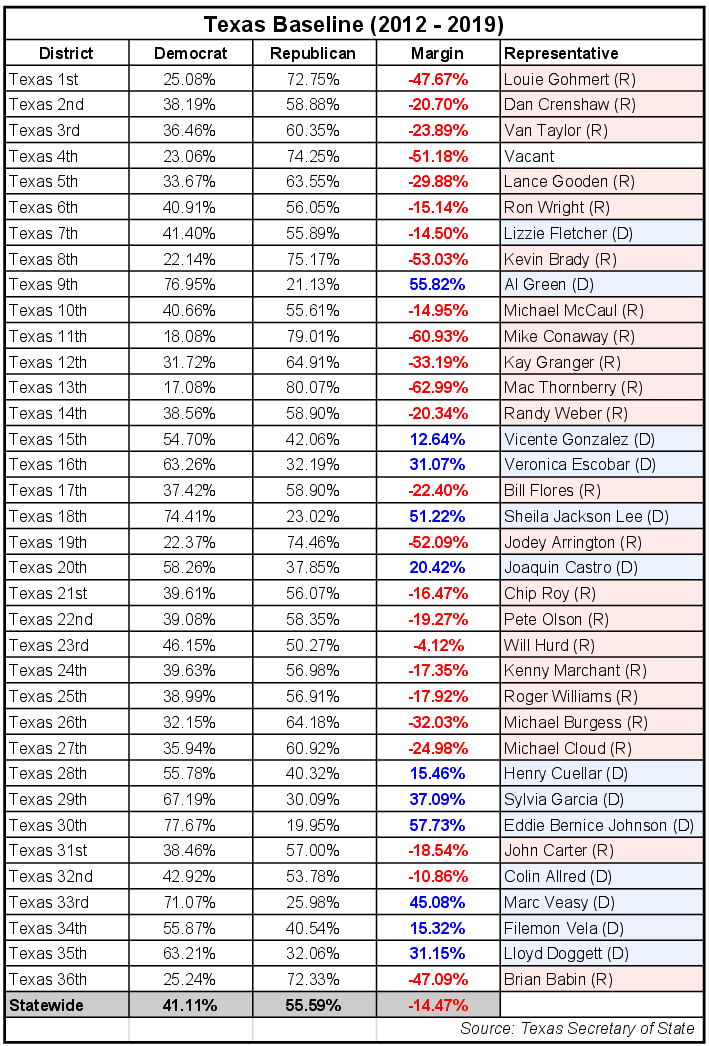Breaking Down Texas Districts With Baseline Metric
October 12, 2020 · 9:59 AM EDT
As a presidential battleground with multiple hot House races and a competitive Senate contest, Texas is a legitimate part of the 2020 conservation. Now there’s another way to analyze Texas’ state of competitiveness.
In 2018, Inside Elections revealed two of our new statistics: Baseline and Vote Above Replacement (VAR).
Baseline captures a state or congressional district’s political performance by combining all federal and state election results over the past four election cycles into a single average. After the midterms, we rolled out Baseline at the state-level for all 50 states.
While Baseline can be calculated at the state level, it can also be calculated for individual congressional districts. We are excited to start rolling out Baseline statistics at the district level, and to start, we are releasing Baseline by district for Texas.
Republican-Leaning Districts
One key takeaway from Texas Baseline by district is that a clear majority of districts lean Republican. Of the state’s 36 congressional districts, 25 have Republican Baselines, which makes sense since Texas has been a Republican-leaning state over the last five decades (the state’s Baseline is R+14.47).
It’s also notable though that 23 of the state’s 36 congressional districts have Baselines that are more Republican than the state as a whole. The median district in Texas has a Baseline of R+17.64, which suggests that a Democrat running statewide would probably need to win by several points before being favored to carry a majority of the state’s congressional districts.
This Republican lean at the district-level is reflected in its U.S. House delegation, which has 22 Republicans, 13 Democrats, and 1 vacancy. Rep. Lizzie Fletcher (7th District) and Rep. Colin Allred (32nd District) are the two Democrats who represent districts with Republican Baselines. No Republican represents a district with a positive Democratic Baseline -- Rep. Will Hurd (23rd District) comes the closest (R+4.12). Republican Rep. Mac Thornberry (13th District) represents the most Republican district (R+62.99) while Democratic Rep. Eddie Bernice Johnson (30th District) represents the most Democratic district (D+57.73).
Democratic Gains in the Suburbs
Another key takeaway is that Democrats have recently made rapid gains in several Republican-leaning suburban districts. In 2018, Democrat Beto O’Rourke lost the Senate race by 2.57 percentage points, outperforming Texas’ Baseline margin of R+14.47 by 11.9 percentage points.
In four districts, O’Rourke’s margin was more than 20 percentage points better than the district’s Baseline. These districts were the 7th District (21.8 percent overperformance), 32nd District (21.4 percent overperformance), 24th District (20.8 percent overperformance), and 3rd District (20.6 percent overperformance). These four suburban districts are located in the two largest metropolitan areas of the state (Dallas-Fort Worth and Houston) and have relatively high education levels (median of 49.6% of adults with a bachelor’s degree or higher).
It is clear that these districts have rapidly evolved from heavily Republican districts in the Obama era to swing districts in the Trump era. Moving forward, it will be interesting to see if Democratic gains in places like these continue, especially if President Donald Trump loses re-election.
After the 2020 elections, each district will have a new Baseline, which should make those shifts easier to identify. And we’ll roll out Baseline for districts in other states before and after November.
